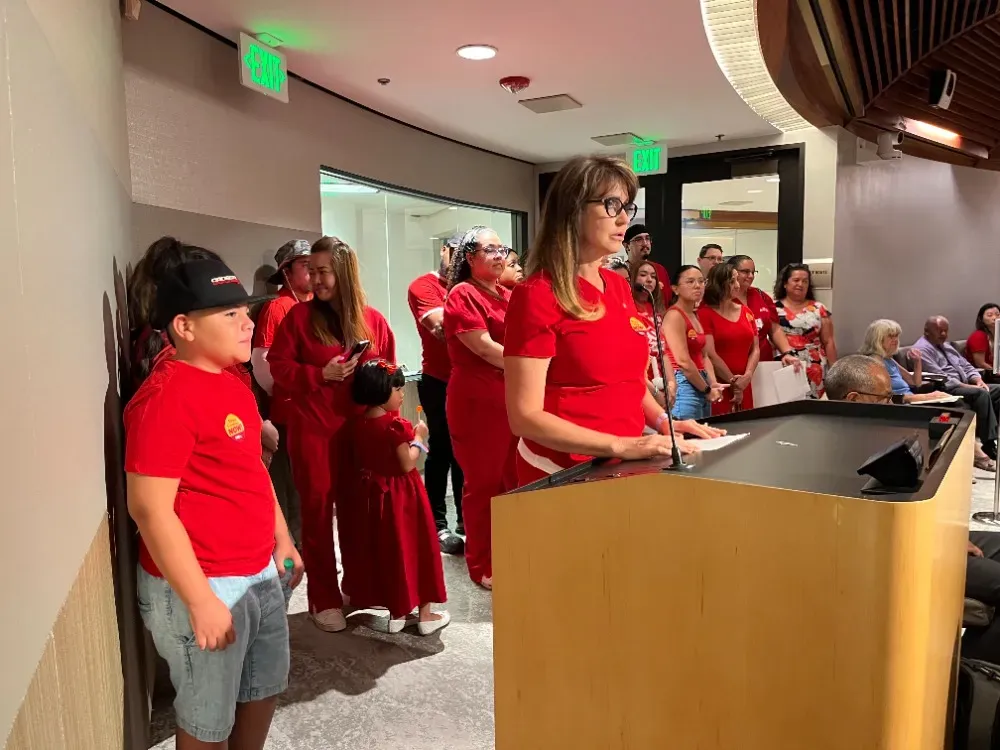San Bernardino County Nurses Demand Action for Patient Safety

On August 6, 2024, registered nurses from San Bernardino County made a powerful statement during the Board of Supervisors meeting, raising urgent concerns about severe patient safety issues resulting from chronic short staffing. With over 125 reported incidents of unsafe patient care at Arrowhead Regional Medical Center (ARMC) alone, these dedicated professionals, represented by the California Nurses Association/National Nurses United (CNA/NNU), are calling for immediate action to address staffing shortages and improve patient care.
The Crisis in Patient Care
San Bernardino County’s healthcare system is currently facing a significant staffing crisis, with more than 300 nursing positions remaining vacant at ARMC. This shortage is a pressing issue, impacting not just the quality of care but also the morale and sustainability of the nursing workforce. Diana Lucatero, a registered nurse in ARMC’s medical intensive care unit, emphasized the urgency of the situation: “We must stand behind our hospital’s mission statement and make the necessary changes to provide our community with a hospital that focuses on maintaining the highest standards in patient care. The safety of our patients needs to be the top priority.”
The repercussions of these vacancies are evident. According to reports, ARMC had 317 vacancies in April 2024, with discrepancies in reported figures revealing only 161 positions listed as ‘approved-to-fill.’ Veronica Morales, an RN in ARMC’s case management unit, expressed frustration over this discrepancy, stating, “When we asked ARMC for a list of vacancies, it only showed 161. After reaching out to HR, we were told these were ‘approved-to-fill’ vacancies, but prior reports didn’t reflect that approval.”
Impact on Patient Care
The shortage of nurses has had a tangible impact on patient care, particularly in intensive care units. Lucatero noted the difficulties faced in providing adequate care: “Before the pandemic, we could get our ventilated patients up for walks. Now, due to staffing issues, our patients are weakening day by day as we don’t have the staff or resources, making it tougher to rehabilitate them.”
This issue extends beyond ARMC, with similar problems reported across the county in various departments, including public health, behavioral health, and the sheriff’s and probation departments. The common thread is inadequate staffing and poor working conditions, which have driven many nurses to leave the profession.
Calls for Reform
The CNA/NNU is advocating for a new contract to address these critical issues. Leslie Oyes, a burn unit nurse at ARMC, highlighted the need for reform: “Providing the resources needed to care for our patients and our community in the way they should be cared for is crucial. Prioritizing recruitment and retention of nurses during these negotiations is paramount to resolving the nurse staffing crisis the county has been struggling with for years.”
The urgency of the situation is further underscored by Stacy Medina, a registered nurse in ARMC’s labor and delivery unit. Medina expressed concerns over management’s proposal to cancel nurses mid-shift, exacerbating the staffing shortage: “We are already short-staffed, and now management wants the ability to cancel nurses? This only hurts our patients. To ensure we provide the highest standard of care, we need a strong union contract that provides fair wages, benefits, and essential working conditions to attract and retain skilled nurses.”
Addressing the Misconceptions
Despite claims of a national nurse shortage, data from the Bureau of Labor Statistics and the National Council of State Boards of Nursing reveal that over 166,000 registered nurses in California alone have active licenses but are not currently working in hospitals. Nationwide, more than a million RNs hold active licenses but have opted out of bedside roles, citing unsafe working conditions as a primary factor.
Morales pointed out the need for systemic change: “The county needs to invest in nurses to prevent short staffing by improving working conditions and providing a safe and healthy environment. We are demanding the county to do the following: prioritize RN retention and recruitment, staff by acuity according to Title 22, including state-mandated nurse/patient ratios at all times, prioritize patient care and safety of nurses, workers, and patients, provide dedicated meal and break coverage in compliance with SB 1334, and finally—respect the union right of nurses and our role as patient advocates.”
Support
As San Bernardino County nurses await a response from the Board of Supervisors, their demands for a new union contract remain focused on addressing the critical issues of staffing and patient safety. The commitment to safeguarding patient care and supporting the nursing workforce is not only a matter of professional integrity but also a crucial investment in the health and well-being of the community.
Diana Lucatero’s call to action encapsulates the collective sentiment: “The community deserves better. We need a contract that reflects our commitment to providing the highest standards in care, and that starts with the county investing in its nurses.” The ongoing negotiations and potential reforms will play a pivotal role in shaping the future of patient care and the nursing profession in San Bernardino County.
